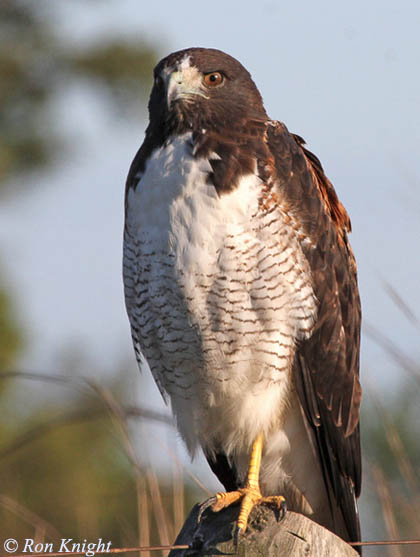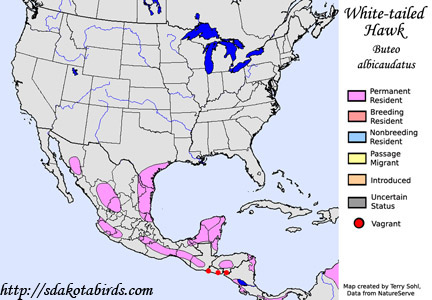White-tailed Hawk
Geranoaetus albicaudatus
| Length: 20 inches | Wingspan: 50 inches | Seasonality: Non-resident in South Dakota |
| ID Keys: Dark upperparts and light underparts, rufous shoulder, white tail with band is unique for Buteo raptors | ||
 The
White-tailed Hawk is a Buteo of the tropics that only reaches the U.S. in
extreme southern Texas, where it can be fairly common. They can also
be found in parts of Mexico, Central America, and much of South America.
They are most commonly found in open habitats with scattered trees and
shrubs. They are one of many species that seems well adapted to
natural fire regimes, and are often attracted to grassland or shrubland
fires as they hunt small animals attempting to flee from the fire's path.
The
White-tailed Hawk is a Buteo of the tropics that only reaches the U.S. in
extreme southern Texas, where it can be fairly common. They can also
be found in parts of Mexico, Central America, and much of South America.
They are most commonly found in open habitats with scattered trees and
shrubs. They are one of many species that seems well adapted to
natural fire regimes, and are often attracted to grassland or shrubland
fires as they hunt small animals attempting to flee from the fire's path.
Habitat: White-tailed Hawks are mostly found in open grasslands with some scattered taller vegetation such as tall shrubs or small trees.
Diet: Feeds on a variety of small prey animals, including small mammals such as rodents and rabbits, frogs, snakes, lizards, birds, and large insects.
Behavior: Hunts by observing from a perch and swooping down to grab prey when spotted, or by hunting in active flight, capturing prey with fast steep dives.
Nesting: The nest of a White-tailed Hawk is a large platform of sticks, usually built lower to the ground than most Buteo nests, typically around 10 feet from the ground. Both the male and females will help to build the nest, incubate the eggs, and help to raise the young.
Song: High laughing screech
Migration: Considered a permanent resident throughout its range, although some birds make short distance movements after breeding.
Interactive eBird map: Click here to access an interactive eBird map of White-tailed Hawk sightings
Similar Species: Swainson's Hawk, Short-tailed Hawk, Broad-winged Hawk
Conservation Status: There are currently no perceived major threats to White-tailed Hawk populations, and the IUCN cites it as a species of "Least Concern".
Further Information: 1) Wikipedia - White-tailed Hawk
2) Audubon Guide - White-tailed Hawk
3) WhatBird - White-tailed Hawk
Photo Information: Photo by Ron Knight - Photo licensed under Creative Commons Attribution 2.0 Generic License
Additional Photos: Additional Photos Coming Soon!!
| Click below for a higher-resolution map |
 |
| South Dakota Status: Non-resident in South Dakota |
Additional White-tailed Hawk Photos (coming soon!!)
